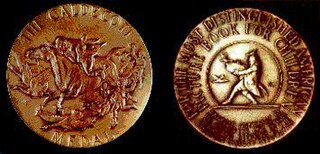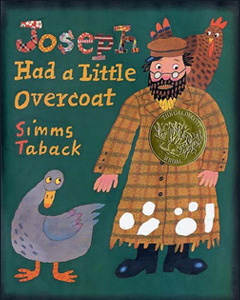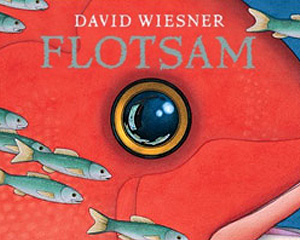
The John Newbery Medal, frequently shortened to the Newbery, is a literary award given by the Association for Library Service to Children (ALSC), a division of the American Library Association (ALA), to the author of "the most distinguished contributions to American literature for children". The Newbery and the Caldecott Medal are considered the two most prestigious awards for children's literature in the United States. Books selected are widely carried by bookstores and libraries, the authors are interviewed on television, and master's theses and doctoral dissertations are written on them. Named for John Newbery, an 18th-century English publisher of juvenile books, the winner of the Newbery is selected at the ALA's Midwinter Conference by a fifteen-person committee. The Newbery was proposed by Frederic G. Melcher in 1921, making it the first children's book award in the world. The physical bronze medal was designed by Rene Paul Chambellan and is given to the winning author at the next ALA annual conference. Since its founding there have been several changes to the composition of the selection committee, while the physical medal remains the same.

The Randolph Caldecott Medal, frequently shortened to just the Caldecott, annually recognizes the preceding year's "most distinguished American picture book for children". It is awarded to the illustrator by the Association for Library Service to Children (ALSC), a division of the American Library Association (ALA). The Caldecott and Newbery Medals are considered the most prestigious American children's book awards. Beside the Caldecott Medal, the committee awards a variable number of citations to runners-up they deem worthy, called the Caldecott Honor or Caldecott Honor Books.

Ricky Ricotta's Mighty Robot is a series of children's graphic novels written by Dav Pilkey and first seven books illustrated by Martin Ontiveros and all nine books, including two long-awaited sequels, illustrated by Dan Santat. In each book, Ricky Ricotta, a mouse, with the help of his mighty robot, saves the world from an evil villain. Also, the books each have an alien animal from a different planet in order from closest-to-sun to farthest-from-sun including Earth, as the villain of the first book is from Earth. The reader could see the villains being jailed in each series and later notice the familiar villains from previous books.

Randolph Caldecott was a British artist and illustrator, born in Chester. The Caldecott Medal was named in his honour. He exercised his art chiefly in book illustrations. His abilities as an artist were promptly and generously recognised by the Royal Academy. Caldecott greatly influenced illustration of children's books during the nineteenth century. Two books illustrated by him, priced at a shilling each, were published every Christmas for eight years.

Joseph Had a Little Overcoat is a 1999 children’s picture book by Simms Taback that won the 2000 Caldecott Medal. The book is a re-illustrated version of a book of the same name by Taback that was published in 1977. The protagonist is Joseph, a Jewish farmer, who has a little striped overcoat. When it grows old, Joseph makes it into a little jacket and so on until he makes it into a button. Ultimately, Joseph loses the button, but is prompted to write a book based on his experiences. The moral of the story is "you can always make something out of nothing." In 2001, an 11-minute animated film based on the book, directed by Daniel Ivanick and narrated by Rob Reiner, was made by Weston Woods Studios, Inc.

Time of Wonder is a 1957 children's picture book written and illustrated by Robert McCloskey that won the Caldecott Medal in 1958. The book tells the story of a family's summer on a Maine island overlooking Penobscot Bay, filled with bright images and simple alliteration. Rain, gulls, a foggy morning, the excitement of sailing, the quiet of the night, and the sudden terror of a hurricane are all expressed in this book. This was McCloskey's second Caldecott, the first being Make Way for Ducklings in 1942.
Paul O. Zelinsky is an American illustrator and writer who illustrated children's picture books. He won the 1998 Caldecott Medal for U.S. picture book illustration, for Rapunzel. His most popular work is Wheels On the Bus, a best-selling movable book.

Flotsam is a children's wordless picture book written and illustrated by David Wiesner. Published by Clarion/Houghton Mifflin in 2006, it was the 2007 winner of the Caldecott Medal; the third win for David Wiesner. The book contains illustrations of underwater life with no text to accompany them.

My Friend Rabbit is a children's picture book written and illustrated by Eric Rohmann and first published in 2002. The illustrations in the book earned Rohmann the Caldecott Medal in 2003. My Friend Rabbit was adapted into an animated television series in 2007.

Dan Santat is an American author and illustrator known for his children's book The Adventures of Beekle: The Unimaginary Friend, which won the 2015 Caldecott Medal for distinguished illustration. He also wrote The Guild of Geniuses and created the Disney Channel animated series The Replacements. He was awarded the 2023 National Book Award for A First Time for Everything.

The Lion & the Mouse is a 2009 nearly wordless picture book illustrated by Jerry Pinkney. This book, published by Little, Brown and Company, tells Aesop's fable of The Lion and the Mouse. In the story, a mouse's life is a spared by a lion. Later, after the lion is trapped, the mouse is able to set the lion free. Adapting the fable, with the moral that the weak can help the strong, as a wordless picture book was seen as a successful way of overcoming the brief plot generally found in the source stories. While it was Pinkney's first wordless picture book, it was not the first time he had told the story, having previously included it in his Aesop's Fables, published in 2000. Pinkney, who had received five Caldecott Honors, became the first African American to win the Caldecott Medal for his illustrations in this book. His illustrations were generally praised for their realism and sense of place. The cover illustrations, featuring the title characters but no text, drew particular praise.

A Sick Day for Amos McGee is a 2010 children's picture book written by Philip C. Stead and was illustrated by Erin E. Stead. The book, published by Roaring Brook Press, depicts a zookeeper who has bonded with the animals he cares for and who come and visit him one day when he gets sick. Phillip Stead wrote the book hoping his wife Erin would illustrate it after a period where she had become discouraged with her art. The book was well reviewed, and Erin won the 2011 Caldecott Medal for her illustrations. The book received praise for its woodblock illustrations and for its message about what friends will do to help and support each other.

Mac Barnett is an American writer of children's books living in Oakland, California.

Jillian Tamaki is a Canadian American illustrator and comic artist known for her work in The New York Times and The New Yorker in addition to the graphic novels Boundless, as well as Skim and This One Summer written by her cousin Mariko Tamaki.

This Is Not My Hat is a 2012 American children's picture book by the author and illustrator Jon Klassen. The story is told through the unreliable narration of a little fish, who has stolen a hat from a big fish and how the big fish reacts to the theft. It is a thematic follow-up to I Want My Hat Back (2011) and was meant to be a more literal sequel until Klassen took a suggestion to change which animals were in the story. The book was well received by critics who praised its dark or ironic humor which could only be understood by comparing the words of the little fish's narration against the events of the illustrations. In addition to several positive reviews, Klassen received the 2013 Caldecott Medal and the 2014 Kate Greenaway Medal becoming the first book to win both awards. This is Not My Hat was also a commercial success.

Finding Winnie: The True Story of the World's Most Famous Bear is a 2015 children's book written by Canadian author Lindsay Mattick and illustrated by Sophie Blackall. The non-fiction book is framed as a story Mattick is telling to her son. Her great-grandfather, Harry Colebourn bought a bear on his way to fight in World War I, donating the bear to a zoo where it became the inspiration for the character of Winnie-the-Pooh. Finding Winnie was thoroughly researched by both Blackall and Mattick. The book's writing and illustrations were well reviewed and it won the 2016 Caldecott Medal.

Radiant Child: The Story of Young Artist Jean-Michel Basquiat is a 2016 picture book biography by Javaka Steptoe about Jean-Michel Basquiat. Using a style similar to Basquiat's, the book tells the story of his childhood and early career. It won the 2017 Caldecott Medal and Coretta Scott King Illustrator Award for its illustrations.

Wolf in the Snow is a 2017 wordless picture book by Matthew Cordell. The book was favorably received by critics and won the 2018 Caldecott Medal. The story has drawn comparisons to fairy tales like Little Red Riding Hood. The nearly wordless book tells the story of a girl and wolf who each get lost in the snowstorm. Cordell used distinctive illustration techniques for the girl and the wolf.

The Rough Patch is a 2018 picture book by Brian Lies. An idea of Lies' for more than ten years, when it was published it was well received and was named a 2019 Caldecott Honor book. The story tells of a fox named Evan whose dog dies. Evan then experiences various emotions while grieving before adopting a new dog at the end of the book. The book was praised for Lies' mixed media illustrations, in particular the way he used light and shadow.

The Imaginary is a 2014 British children's novel written by A. F. Harrold and illustrated by Emily Gravett. It is about a small girl, Amanda, and her imaginary friend, Rudger. An anime film adaptation by Studio Ponoc has been announced. Initially set for a Q3 2022 release, it was later delayed to 15 December 2023 due to production issues.


















